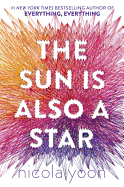
Nicola Yoon's The Sun Is Also a Star is a love story that feels timeless in its cosmic examination of what makes the human heart beat faster (think Keats) and yet is decidedly modern (think IKEA references and the word "ass" used as an adjective).
The novel--a finalist for the 2016 National Book Award for Young People's Literature--largely unfolds in the alternating first-person voices of two star-crossed lovers in New York. Seventeen-year-old high school senior Natasha Kingsley is a Jamaican-born black girl from Brooklyn. Daniel Bae, also 17, is the son of Korean immigrants and lives in Harlem. There are more than two sides to this story. Yoon (Everything, Everything) deepens her narrative with interruptions from an omniscient narrator who not only discusses multiverses, fate and the Jamaican word "irie," but also offers a lively chorus of perspectives.
Natasha first encounters Daniel in Manhattan on the day her family is scheduled to be deported. Daniel--on his way to a college admissions interview--spots Natasha with her "enormous, curly Afro and almost-as-enormous pink headphones" and follows her into a record store. Witty repartee ensues and sparks fly for the next 12 hours; that there's "something big" between them is undeniable. Despite his "poem-writing tendencies," science-minded Natasha likes this fine, funny, earnest boy way too much for a girl who's about to leave the country forever.
The Sun Is Also a Star--an exhilarating, hopeful novel exploring identity, family, the love of science and the science of love, dark matter and interconnectedness--is about seeing and being seen and the possibility of love... and it shines. --Karin Snelson, children's & YA editor, Shelf Awareness

